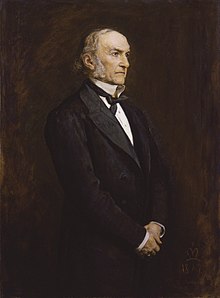Gladstonian liberalism

| This article is part of a series on |
| Liberalism in the United Kingdom |
|---|
 |
| Part of a series on |
| Capitalism |
|---|
Gladstonian liberalism is a political doctrine named after the British Victorian Prime Minister and
Gladstonian financial rectitude had a partial lasting impact on British politics and the historian John Vincent contends that under Lord Salisbury's premiership he "left Britain's low tax, low cost, low growth economy, with its Gladstonian finance and its free trade dogmas, and no conscript army, exactly as he had found it...Salisbury reigned, but Gladstone ruled".[4] In the early 20th-century the Liberal Party began to move away from Gladstonian liberalism and instead developed new policies based on social liberalism (or what Gladstone called "constructionism"). The Liberal government of 1905–1914 is noted for its social reforms and these included old age pensions and National Insurance. Taxation and public expenditure was also increased and New Liberal ideas led to David Lloyd George's People's Budget of 1909–1910.
The first
Gladstonian era
For thirty years Gladstone and liberalism were synonymous. William Ewart Gladstone served as Prime Minister four times (1868–1874, 1880–1885, 1886 and 1892–1894). His financial policies, based on the notion of balanced budgets, low taxes and laissez-faire, were suited to a developing capitalist society. Called the "Grand Old Man" later in life, Gladstone was a dynamic popular orator who appealed strongly to the working class and to the lower middle class. Deeply religious, Gladstone brought a new moral tone to politics, with his evangelical sensibility and his opposition to aristocracy.[6] His moralism often angered his upper-class opponents (including Queen Victoria) and his heavy-handed control split the Liberal Party.[7][8]
In foreign policy, Gladstone was in general against foreign entanglements, but he did not resist the realities of imperialism. For example, he approved of the occupation of Egypt by British forces in 1882. His goal was to create a European order based on co-operation rather than conflict and on mutual trust instead of rivalry and suspicion whilst the rule of law was to supplant the reign of force and self-interest. This Gladstonian concept of a harmonious Concert of Europe was opposed and ultimately defeated by a Bismarckian system of manipulated alliances and antagonisms.[9]
As Prime Minister from 1868 to 1874, Gladstone headed a Liberal Party which was a coalition of
The (Anglican) Church of Ireland, serving a small minority of the Irish, was disestablished through the Irish Church Act 1869. Catholics no longer had to pay taxes to it.[16] Other Liberal efforts focused on land reform, where the First Irish Land Act in 1870 entitled Irish tenants, if evicted, to compensation for any improvements which they had made to their land.
In the
Gladstone's second government was dominated by Irish affairs. The
There was a final weak Gladstone ministry in 1892, but it also was dependent on Irish support and failed to get Irish Home Rule through the House of Lords. Gladstone finally retired in 1894, ostensibly because of his opposition to what he saw as excessive spending on the Royal Navy but in reality because his Cabinet refused to support his wish to curb the powers of the House of Lords. Following the Conservatives' creation of elected county councils in 1888, district and parish councils were created by the Liberals in 1894. Gladstone's successor, the Earl of Rosebery, led the party to another heavy defeat in the 1895 general election.
See also
References
- ^ Heffer, Simon (10 May 2013). "Margaret Thatcher was not right-wing". New Statesman. Archived from the original on 7 June 2013. Retrieved 28 June 2017.
- ISBN 978-1-134-76694-9.
- ^ "Liberalism rediscovered". The Economist. 5 February 1998. Retrieved 28 June 2017.
- ^ Vincent, John (24 July 1999). "Reigning not Ruling". The Spectator.
- ^ Taylor, A. J. P. (1990). English History, 1914–1945. Oxford University Press. p. 212.
- ^ Parry, J. P. (1989). Democracy and Religion: Gladstone and the Liberal Party, 1867–1875. Cambridge University Press. p. 174.
- doi:10.1093/ref:odnb/10787. (Subscription or UK public library membershiprequired.)
- ^ Hammond, J. L.; Foot, M. R. D. (1952). Gladstone and Liberalism. London: English Universities Press.
- ^ Goodlad, Graham D. (2000). British foreign and imperial policy, 1865–1919. London: Routledge. p. 21.
- ^ Roy Jenkins, Gladstone: A Biography (1997) pp 293–378.
- ^ Clayton Roberts and David Roberts, A History of England: 1688 to the Present (3rd ed. 1991) pp 623–24.
- ^ D. W. Sylvester, "Robert Lowe and the 1870 Education Act." History of Education 3.2 (1974): 16–26.
- ^ David O'Keefe, "Sir George Jessel and the Union of Judicature." American Journal of Legal History 26 (1982): 227+.
- ISBN 9781576079256.
- ISBN 9781783085309.
- ISBN 9780889208766.
- S2CID 154679807.
- ^ Ian Cawood, The Liberal Unionist Party: A History (2012) pp 13–41.
Further reading
- Biagini, Eugenio F. Liberty, retrenchment and reform: popular liberalism in the age of Gladstone, 1860–1880 (Cambridge UP, 2004).
- Clarke, Peter F. Lancashire and the new liberalism (Cambridge UP, 2007).
- Hammond, J. L.and M. R. D. Foot. Gladstone and Liberalism (1952).
- Kelley, Robert L. The Transatlantic Persuasion: The Liberal-Democratic Mind in the Age of Gladstone (1977).
- Lubenow, William C. "The Liberals and the National Question: Irish Home Rule, Nationalism, and their Relationship to Nineteenth‐Century Liberalism." Parliamentary History 13.1 (1994): 119–142.
- Moore, James. The Transformation of Urban Liberalism: Party Politics and Urban Governance in Late Nineteenth-century England (Routledge, 2017).
- Parry, Jonathan. The politics of patriotism: English liberalism, national identity and Europe, 1830–1886 (Cambridge UP, 2006).
- Vincent, Andrew. "The New Liberalism in Britain 1880–1914." Australian Journal of Politics & History 36.3 (1990): 388–405.
- Warren, Allen. "‘The Return of Ulysses’: Gladstone, Liberalism and Late Victorian Politics." Parliamentary History 9.1 (1990): 184–196.
